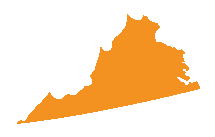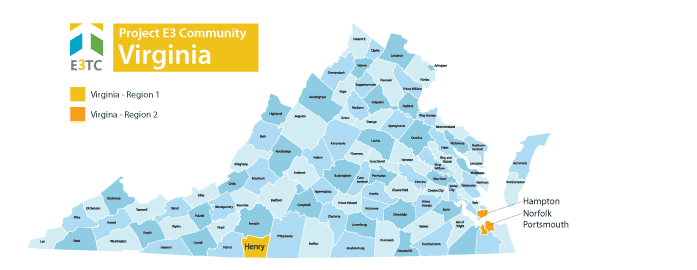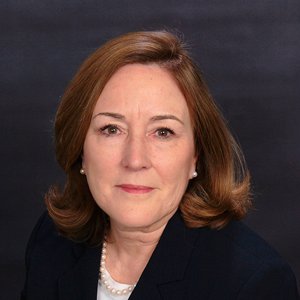Virginia was chosen as a targeted community through the Vocational Rehabilitation Technical Assistance Center: Targeted Communities (VR-TAC-TC) or Project E3. Project E3 partnered with State VR Agencies and local community partners to improve outreach and employment-related services to underserved people with disabilities in these communities.

Virginia is located between the Atlantic Coast and the Appalachian Mountains in the Southeast. It is the 35th largest state by area. Forests cover 65% of the state and the climate is humid and fairly warm, with daytime temperatures ranging from the mid 40’s to the mid 80’s throughout the year. The five regions of the state include coastal plains, mountains, valleys and rivers.
Coal mining is an important part of the state’s economy, along with farming, business, and the military. Virginia is also known as “the Mother of Presidents” as eight U.S. Presidents were born there. The state has 30 National Park Service units, such as the Appalachian Trail and the Shenandoah National Park.
The southeastern region of Virginia is identified as the Hampton Roads Region. It is known for its large military presence, ice-free harbor, shipyards, coal piers, and miles of waterfront. All of these contribute to the diversity and stability of the region's economy.
Targeted Communities
The state-federal vocational rehabilitation system in Virginia faced many challenges as it strove to serve people with significant disabilities and promote competitive integrated employment. Project E3 provided intensive technical assistance to two regions of the state:

Key Information:
Substance Abuse
Highest Emergency Room Overdose Rate
involving unintentional opioid, heroin, or “unknown substance” related overdoses in January 2017.
Lowest Hourly Wage
Average wage for people with a substance abuse disability is significantly lower than the average hourly wage for consumers of all disabilities.
Poverty Rate
State rate = 11.2%
National rate = 11.3%
Unemployment
State rate = 3.6%
National rate = 4.1%
Vocational Rehabilitation
Services from the Virginia Department of Aging and Rehabilitation Services (DARS)
Sheltered Workshops
The oldest and largest of these is in Martinsville.
Targeted Populations
These populations were characterized as:
Primary Challenges for Targeted Populations
Some of the challenges of this population in Virginia included:
Key Strategies to Address Barriers
Following are some of the key strategies developed and implemented to address the targeted populations' challenges and barriers to employment.
Community Based Participatory Research (CBPR): To understand a community’s issues and concerns, one needs data and information both supplied by common data sources and interpreted by the community to better understand their issues and possible solutions to those issues. CBPR’s methodology is predicated on deep and extensive community involvement in the identification of issues and concerns and in the resolution of those issues and concerns.
Community Outreach and Orientation: The goal of community outreach and orientation is increased referrals for vocational rehabilitation services from community-based organizations and applications from people with disabilities. To achieve this goal, developing relationships within local communities is essential. Community outreach and building knowledge about the hiring people with disabilities is key.
Poverty and Disability: Bridges Out of Poverty - It is difficult for many individuals including professionals in the field to understand the extent of challenges facing individuals living in poverty and trying to work their way out of poverty. “Bridges Out of Poverty” is excellent training on cultural responsiveness for working with people and communities that experience poverty. It is a proprietary training program so for more information click on this link: aha! Process - Poverty Reduction Professional Development and Solutions (ahaprocess.com)
Financial Literacy Training: When persons with disabilities start their first job or return to work, many have limited understanding of basic financial principles which can increase their wealth and help them manage their income. George Washington University worked with Virginia’s targeted communities to train staff in financial wellness, financial goals, ABLE accounts, Social Security Work Incentives and Virginia’s DARS’ Financial Health Assessment, Benefits Planning and the “Your Money, Your Goals” toolkit from the Consumer Financial Protection Bureau. There was a partnership with the New York City Department of Consumer Affairs to train volunteers in their Financial Empowerment Counselor training.
Integrated Resource Teams: To overcome shortage of resources, overlapping services, lack of information, and coordinated planning, Integrated Resource Teams (IRTs) are an excellent way to structure collaborative working arrangements as well as consider options for the blending and braiding of services and funding. IRT membership depends on the locale and existing working relationships and can include Vocational Rehabilitation, education, social services, Workforce, faith-based organizations, mental health agencies, veteran’s agencies, etc.
- Planning Form: Integrated Resource Teams
- Planning Form Example: Integrated Resource Teams
- Mapping Exercise: Integrated Resource Teams
- Presentation 4: Integrated Resource Teams
- Presentation 5: Integrated Resource Teams
Comprehensive Support Systems and Capacity Building: Community Academy – Not all potential community partners and community based organizations understand the intersection of poverty, disability and employment. The Community Academy is a good educational approach. A typical Academy has the following elements: Introduction of Community Academy concept, logistics, and implementation for both an “in person” and “virtual” Community Academy. Training participants will leave with step by step instructions on how to plan and carry out a Community Academy as well as tools, including a sample invitation, sample registration form, and suggested list of foundational organizations to participate, to support them in hosting their own Community Academy.
Virginia Overview PowerPoint Presentation
Project Outcomes
Project E3 provided Virginia’s state Vocational Rehabilitation agencies and their partners with the skills and competencies needed to effectively and efficiently address barriers to competitive integrated employment and community integration encountered by persons with disabilities in these regions.
Our specific goals for this project were to:
We will leverage promising practices, knowledge, and experience gained from this project to expand employment opportunities for individuals with disabilities from underserved and economically disadvantaged populations throughout Virginia and across the United States.
Continuation and Sustainability Plan
Tools and Resources
Community Based Participatory Research
Community Outreach and Orientation
Comprehensive Support Systems and Capacity Building
- Community Academy Agenda
- Invite to Community Academy
- Registration to Community Academy
- Sample Invite List Community Academy
- Presentation Slides: Community Academy
Disability and Poverty Training
Integrated Resource Teams
More Information
For further information about these community activities contact:

Maureen McGuire-Kuletz Ed.D., CRC
Co-Director, Center for Rehabilitation Counseling Research & Education
Associate Professor, Rehabilitation Counseling
mkuletz@gwu.edu


